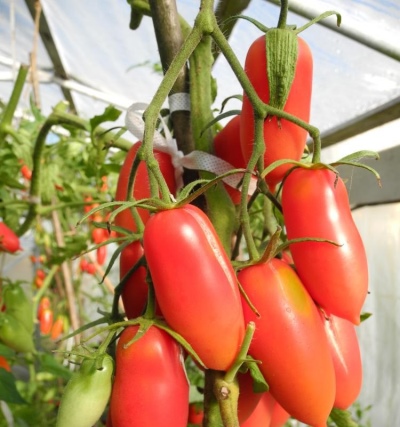
- Authors: Andreeva E.N., Nazina S.L., Bogdanov K.B., Ushakova M.I. (LLC Selection and seed-growing company "Tomagros")
- Year of approval: 2001
- Category: grade
- Growth type: indeterminate
- Appointment: universal
- Ripening period: mid-early
- Ripening time, days: 114
- Growing conditions: for film greenhouses, for closed ground, for greenhouses
- Marketability: high
- Transportability: high
Growing different types of tomatoes on the site, every gardener wants to determine for himself a favorite and universal variety that will be tasty both fresh and canned. These include the mid-early Varvara variety.
Breeding history
The nightshade culture Varvara was bred by a group of domestic breeders (Bogdanov, Ushakova, Andreeva and Nazina) in 2000. The variety was bred for cultivation in greenhouse conditions and under film shelters. The variety was included in the State Register and approved for use in 2001. Recommended for breeding and cultivation in all regions of the country.
Description of the variety
Vegetable culture Varvara is a medium-sized plant with an indeterminate type of growth. The bush grows up to 120-150 cm and is characterized by moderate thickening of dark green leaves, strong stems, simple inflorescences and a powerful root system. According to the recommendations of farmers, the bushes need to be tied and pinned. It is better to form a bush in two stems.
The main qualities of the fruit
The Varvara cluster tomato grows to a small size - the average fruit weight is 50-70 grams. The peculiarity is that almost all fruits are endowed with the same size and shape without defects. The tomato has a cylindrical shape with a sharp "nose" and a rich pink color. In an immature state, the fruit is characterized by a green color with darkening at the stalk. The tomato peel is dense with a glossy finish, which protects well from cracking and facilitates the transportation of fruits without significant losses.
Taste characteristics
Compact tomatoes are famous for their high taste. Their flesh is firm, fleshy, moderately juicy. The tomatoes taste sweet, without visible sourness. In addition, Barbarian fruits are rich in antioxidants and trace elements (calcium, magnesium, potassium), as well as plant sugars. The aroma of tomatoes is weak. The advantage of the species is its versatility - tomatoes are suitable for fresh consumption, and are also good for canning and processing into sauces, dressings and salads.
Ripening and fruiting
Barbara is a medium early type of tomato. From the moment the first shoots appear until the fruit tasting period, about 114 days pass. The active fruiting phase lasts in August and September (depending on the climatic conditions of the growing region). Tomatoes ripen gradually, so you can enjoy fresh fruits for a long time. After ripening, the tomatoes do not crumble.
Yield
The crop yields are high. On average, if all the rules of care are observed, up to 5.1 kg of fruits can be harvested from 1 m2. Up to 3 kg of tomatoes are harvested from one bush per season.
The timing of planting seedlings and planting in the ground
Sowing seeds for seedlings is performed 60-65 days before planting the bushes in the ground at a permanent place. The seeds are pre-sorted out, disinfected and hardened. Sowing seeds is carried out in a universal soil. The optimum temperature for growing seedlings is considered to be + 22 ... 25 degrees, as well as illumination for 12-14 hours. At the stage of appearance of 2-3 true leaves, a dive is carried out.
Bushes are planted in the ground in late May - early June.The soil should be warmed up, and the threat of night frost is minimized. A bush transplanted into the ground should have 7-9 leaves and a stem 1 cm thick.

Growing tomato seedlings is an extremely important process, because it largely depends on whether the gardener will be able to harvest at all. All aspects must be taken into account, from seedbed preparation to planting in the ground.
Landing scheme
It is recommended to plant no more than 3-4 seedling bushes per 1 m2. The optimal planting scheme is the following: 40x50 cm.

Growing and care
Before planting seedlings, it is recommended to prepare the site. The soil must be cleared of weeds and debris, dug up to improve air permeability, fertilize and prepare the holes. Do not forget also about the supports for the garter bushes. Tomatoes grow well in the place where legumes and cabbage were previously grown.
Care includes: watering, weeding, feeding according to a certain scheme, pinching, garter and measures to prevent plant diseases.




A plant needs different micronutrients at each stage of growth. All fertilizers can be divided into two groups: mineral and organic. Folk remedies are often used: iodine, yeast, bird droppings, eggshells.
It is important to observe the rate and period of feeding. This also applies to folk remedies and organic fertilizers.
Disease and pest resistance
The variety has high immunity, especially against late blight, foliage wilting and gray / white rot. As a preventive measure, spraying with solutions is effective. Weak immunity of tomatoes to the invasion of pests - aphids, Colorado potato beetle and bear.


Resistant to adverse weather conditions
This seed crop is resistant to extreme climatic conditions such as drought and heat. In addition, a too shaded area is not terrible for tomatoes.
Growing regions
The variety is zoned for cultivation in the climatic conditions of the Russian Federation, Belarus, Ukraine and Moldova, both in open and closed grounds.
Review overview
Analyzing the numerous reviews of gardeners and farmers about Varvara tomatoes, it can be argued that the variety is fruitful, versatile, not capricious in care, and is also ideal for whole-fruit canning. Among the shortcomings, one can point out the cracking of the fruit with an excess of moisture.

























































































